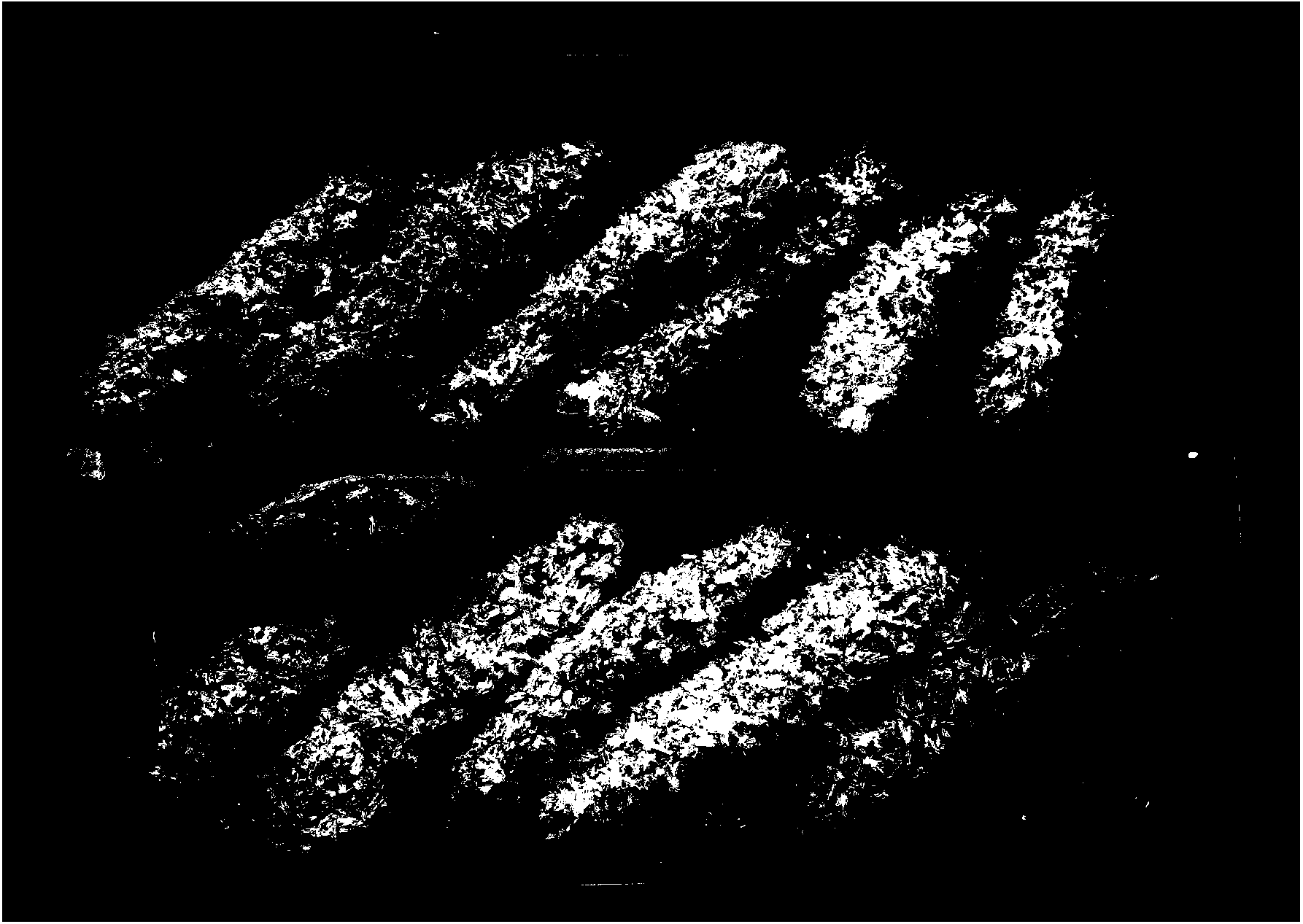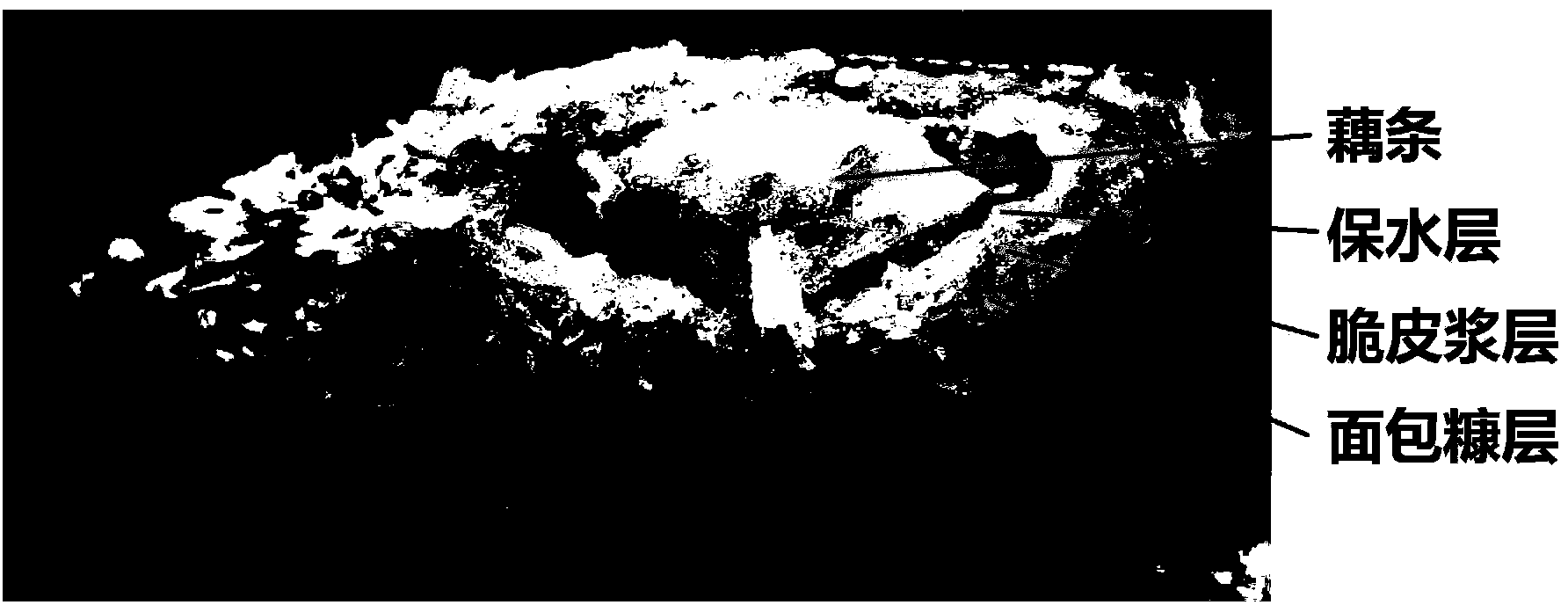Preparation method of deep-fried crispy lotus root strips
A lotus root strips, crispy technology, applied in the field of preparation of fried crispy lotus root strips, can solve the problems of loss of crispy taste, oil-water infiltration and softening, loss of crispness, etc., and achieve the effect of not easy to oxidize and discolor, low production cost, and delicious taste
- Summary
- Abstract
- Description
- Claims
- Application Information
AI Technical Summary
Problems solved by technology
Method used
Image
Examples
Embodiment 1
[0024] A preparation method for deep-fried crispy lotus root strips, comprising the following steps:
[0025] 1) Take fresh lotus root, wash and peel it, and blanching it in hot water containing 0.2% (weight percent) gluconodelta lactone and 2% (weight percent) salt at a temperature of 95° C. for 1 minute, and cooling Then cut into lotus root strips.
[0026] 2) After draining the surface water of the lotus root strips, use the gelatinized starch mucus layer on the surface of the lotus root strips to adhere to the water-retaining layer powder to form a water-proof layer on the surface of the lotus root strips.
[0027] The water-retaining layer powder is composed of the following components: 3g bleached shellac, 2g glucono delta lactone, 50g corn starch and 50g tapioca modified starch, the above components are ground and mixed at low temperature, and passed through a 200-mesh sieve.
[0028] 3) Hang the lotus root strips attached to the water-retaining layer powder with crisp...
Embodiment 2
[0031] A preparation method for deep-fried crispy lotus root strips, comprising the following steps:
[0032] 1) Fresh lotus root is taken, washed and peeled, blanched in hot water containing 0.5% glucono δ lactone and 0.5% salt for 2 minutes, cooled and cut into strips.
[0033] 2) After draining the surface water of the lotus root strips, use the gelatinized starch mucus layer on the surface of the lotus root strips to adhere to the water-retaining layer powder to form a water-proof layer on the surface of the lotus root strips.
[0034] The water-retaining layer powder is composed of the following components: 5g bleached shellac, 3g glucono delta lactone, 40 g Cornstarch and 30g of tapioca modified starch, the above-mentioned ingredients are ground and mixed at low temperature, and passed through a 200-mesh sieve.
[0035] 3) Hang the lotus root strips attached to the water-retaining layer powder with crispy paste, wrap in bread crumbs, fry, degrease, air-cool, and pack. ...
Embodiment 3
[0038] A preparation method for deep-fried crispy lotus root strips, comprising the following steps:
[0039] 1) Fresh lotus root is taken, washed and peeled, blanched in hot water containing 0.1% glucono δ lactone and 1% salt for 0.5 minutes, cooled and cut into strips.
[0040] 2) After draining the surface water of the lotus root strips, use the gelatinized starch mucus layer on the surface of the lotus root strips to adhere to the water-retaining layer powder to form a water-proof layer on the surface of the lotus root strips.
[0041] The water-retaining layer powder is composed of the following components: 1g bleached shellac, 5g glucono delta lactone, 30g cornstarch and 20g tapioca modified starch.
[0042] 3) Hang the lotus root strips attached to the water-retaining layer powder with crispy paste, wrap in bread crumbs, fry, degrease, air-cool, and pack. The frying temperature is 160-170°C for 20 seconds, and 0.5% citric acid and 0.1% liquor are added to the frying oi...
PUM
 Login to View More
Login to View More Abstract
Description
Claims
Application Information
 Login to View More
Login to View More - R&D
- Intellectual Property
- Life Sciences
- Materials
- Tech Scout
- Unparalleled Data Quality
- Higher Quality Content
- 60% Fewer Hallucinations
Browse by: Latest US Patents, China's latest patents, Technical Efficacy Thesaurus, Application Domain, Technology Topic, Popular Technical Reports.
© 2025 PatSnap. All rights reserved.Legal|Privacy policy|Modern Slavery Act Transparency Statement|Sitemap|About US| Contact US: help@patsnap.com


